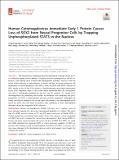Human cytomegalovirus immediate early 1 protein causes loss of SOX2 from neural progenitor cells by trapping unphosphorylated STAT3 in the nucleus
Abstract
The mechanisms underlying neurodevelopmental damage caused by virus infections remain poorly defined. Congenital human cytomegalovirus (HCMV) infection is the leading cause of fetal brain development disorders. Previous work has linked HCMV infection to perturbations of neural cell fate, including premature differentiation of neural progenitor cells (NPCs). Here, we show that HCMV infection of NPCs results in loss of the SOX2 protein, a key pluripotency-associated transcription factor. SOX2 depletion maps to the HCMV major immediate early (IE) transcription unit and is individually mediated by the IE1 and IE2 proteins. IE1 causes SOX2 downregulation by promoting the nuclear accumulation and inhibiting the phosphorylation of STAT3, a transcriptional activator of SOX2 expression. Deranged signaling resulting in depletion of a critical stem cell protein is an unanticipated mechanism by which the viral major IE proteins may contribute to brain development disorders caused by congenital HCMV infection.
Citation
Wu , C-C , Jiang , X , Wang , X-Z , Liu , X-J , Li , X-J , Yang , B , Ye , H-Q , Harwardt , T , Jiang , M , Xia , H-M , Wang , W , Britt , W J , Paulus , C , Nevels , M M & Luo , M-H 2018 , ' Human cytomegalovirus immediate early 1 protein causes loss of SOX2 from neural progenitor cells by trapping unphosphorylated STAT3 in the nucleus ' , Journal of Virology , vol. 92 , no. 17 , e00340-18 . https://doi.org/10.1128/JVI.00340-18
Publication
Journal of Virology
Status
Peer reviewed
ISSN
0022-538XType
Journal article
Description
MHL was supported by the Ministry of Science and Technology of China (National Program on Key Basic Research Project 2015CB755600), the National Natural Science Foundation of China (81620108021, 31170155, and 81427801), the Sino-Africa Joint Research Centre (SAJC201605) and a seed grant from the University of Idaho (YDP-764). MN and CP were supported by the Wellcome Trust Institutional Strategic Support Fund, MN was supported by the Medical Research Council (MR/P022146/1) and Tenovus Scotland (T15/38), and CP was supported by the Deutsche Forschungsgemeinschaft (PA 815/2-1).Collections
Items in the St Andrews Research Repository are protected by copyright, with all rights reserved, unless otherwise indicated.

